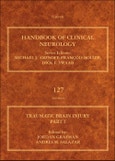The Handbook of Clinical Neurology volume on traumatic brain injury (TBI) provides the reader with an updated review of emerging approaches to traumatic brain injury (TBI) research, clinical management and rehabilitation of the traumatic brain injury patient. Chapters in this volume range from epidemiology and pathological mechanisms of injury, and neuroprotection to long-term outcomes with a strong emphasis on current neurobiological approaches to describing the consequences and mechanisms of recovery from TBI. The book presents contemporary investigations on blast injury and chronic traumatic encephalopathy, making this state-of-the-art volume a must have for clinicians and researchers concerned with the clinical management, or investigation, of TBI.
Please Note: This is an On Demand product, delivery may take up to 11 working days after payment has been received.
Table of Contents
Section 1 Risk and Predisposition 1. Epidemiology 2. Classification of traumatic brain injury: past, present and future 3. Genetic predictors of outcome following TBI
Section 2 Pathology and Mechanisms of Traumatic Brain Injury 4. The neuropathology of traumatic brain injury 5. Cellular and Molecular Mechanisms of Injury and Spontaneous Recovery 6. Injury biomechanics, neuropathology, and simplified physics of explosive blast and impact mild traumatic brain injury 7. Cellular biomechanics of central nervous system injury 8. Animal models of traumatic brain injury
Section 3 Special Considerations 9. Mild traumatic brain injury 10. Acute sports-related traumatic brain injury and repetitive concussion 11. Brain injury from explosive blast: description and clinical management 12. Surgical management of civilian gunshot wounds to the head 13. Acute Loss of Consciousness 14. Systemic manifestations of traumatic brain injury 15. Special Considerations in Infants and Children
Section 4 Current and Emerging Diagnostic Tools 16. Biomarkers 17. Current and future diagnostic tools for traumatic brain injury: CT, conventional MRI, and diffusion tensor imaging 18. Using fMRI and EEG to detect consciousness after severe brain injury 19. Resting Functional Imaging Tools: (MRS, SPECT, PET and PCT) 20. Advances in imaging explosive blast mild traumatic brain injury 21. Electrophysiological recordings in traumatic brain injury
Section 5 Management and Treatment 22. Neuroprotection for traumatic brain injury 23. The prehospital management of traumatic brain injury 24. Acute Management of Military-Related Injury (PHI & Blast) 25. Clinical Management of the Minimally Conscious State 26. Rehabilitation after traumatic brain injury 27. Long-Term Social Integration and Community Support 28. Recent developments in clinical trials for the treatment of traumatic brain injury








